
Aqueous Film Forming Foam, or AFFF, is a firefighting tool designed to smother intense flames, especially in high-risk environments like airports and oil refineries. It creates a barrier that cuts off the oxygen fueling the fire, effectively snuffing it out. However, the properties that make AFFF so effective also pose significant health risks.
Recent studies have highlighted concerns about the chemicals in AFFF and their potential to cause harm.
If you’re curious about the impact and what it means for those exposed, it’s crucial to know about the firefighter foam lawsuit and stay informed about the developments.
Lawsuit Legal News is your number one source when it comes to staying updated about class action lawsuits and mass torts in the US. The information you get from Lawsuit Legal News is crucial to understanding your eligibility to be a part of these lawsuits, their current status, and lots more.
What are PFAS, and Why are They in AFFF?
PFAS are man-made chemicals known for their unique properties, including extreme resistance to water and heat, which is why they earned the nickname “forever chemicals.” Unfortunately, this property also makes them highly persistent in the environment and the human body.
Firefighting foams, particularly AFFF, often contain PFAS as a crucial ingredient. These PFAS work by creating a water-repellent film that smothers flames and prevents flammable liquids from spreading. This effectiveness has made AFFF a critical tool for firefighters battling fuel fires.
How Can You Be Exposed to AFFF?
Firefighters face the highest risk of AFFF exposure due to direct contact during fire suppression activities. Military personnel also frequently encounter AFFF, particularly during training exercises at military bases, where the foam is often used in large quantities.
Additionally, environmental contamination may expose communities near military bases or firefighting training facilities to AFFF. This contamination can seep into water supplies or soil, making its way into residential areas and posing a risk to the health of those living nearby.

The Link Between AFFF Exposure and Health Problems
Research on the health effects of AFFF is ongoing. Still, a growing body of evidence has already established a troubling connection between exposure to AFFF and an increased risk of certain cancers. The chemicals in AFFF, particularly PFAS (per and poly-fluoroalkyl substances), are known for their persistence in the environment and the human body, where they can accumulate over time.
Studies have shown that individuals with prolonged exposure to these chemicals, such as firefighters and military personnel, are at a higher risk of developing cancers such as kidney cancer, testicular cancer, and bladder cancer. These findings have prompted extensive health monitoring and regulations to limit AFFF use and manage existing contamination.
The causal link between AFFF and cancer is supported by the fact that PFAS can interfere with cell growth and hormone functions, critical pathways through which cancers develop. As the evidence mounts, the focus has shifted to understanding the full scope of health effects and finding safer alternatives to AFFF that do not compromise firefighting effectiveness.
Specific Health Conditions Associated with AFFF Exposure
Exposure to AFFF has been linked to several severe health conditions, most notably different types of cancer. Among these, kidney cancer, testicular cancer, and bladder cancer are the most commonly reported in individuals who have had significant contact with this foam.
The persistent nature of the chemicals in AFFF, mainly PFAS, contributes to their cancer-causing potential. These substances can remain in the body for extended periods, disrupting normal cell functions.
Beyond cancer, research suggests that exposure to the chemicals in AFFF may lead to other health issues. For example, there is evidence to suggest an increased risk of thyroid disease, which can affect hormone regulation and metabolism. Furthermore, there are concerns about the impact of these chemicals on the immune system, potentially leading to a decreased immune response and increased susceptibility to infections.
As we continue to understand the full impact of AFFF exposure, the importance of monitoring the health of affected individuals and regulating the use of such substances becomes increasingly clear.
Knowing Your Risk: What to Do if You Were Exposed
If you suspect you’ve been exposed to AFFF, it’s crucial to consult a healthcare professional. Early detection and intervention can significantly affect the outcome, especially in cases related to potential cancer risks. A healthcare provider can guide you through the necessary tests and screenings to assess your exposure levels and related health impacts.
They can also advise on preventive measures and monitoring strategies to manage any health risks associated with AFFF exposure. Staying informed and proactive in monitoring your health is essential to managing the risks linked to AFFF.
Support Northern Colorado Journalism
Show your support for North Forty News by helping us produce more content. It's a kind and simple gesture that will help us continue to bring more content to you.
BONUS - Donors get a link in their receipt to sign up for our once-per-week instant text messaging alert. Get your e-copy of North Forty News the moment it is released!
Click to Donate
